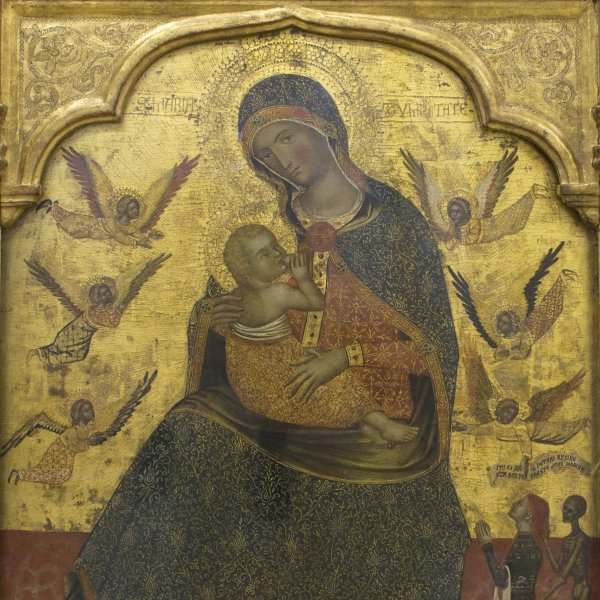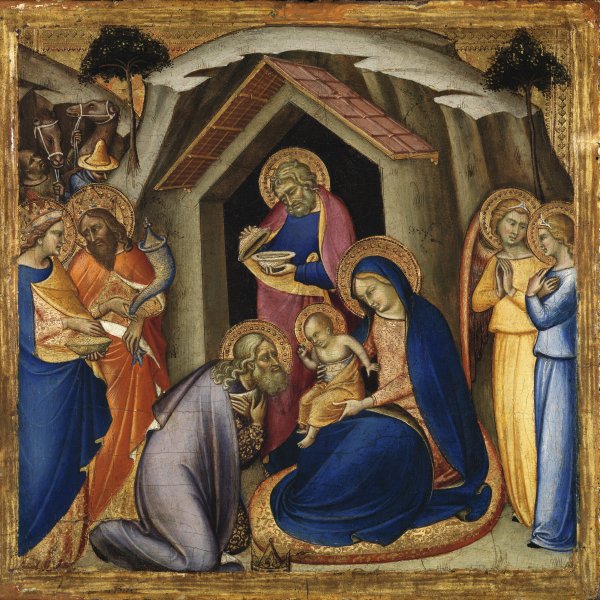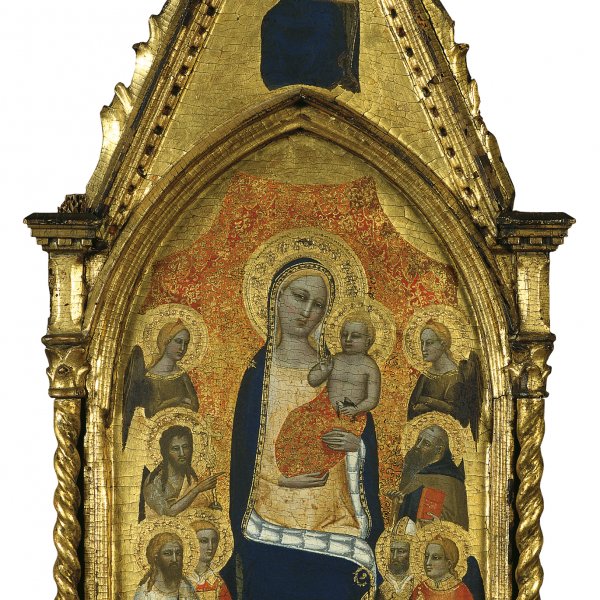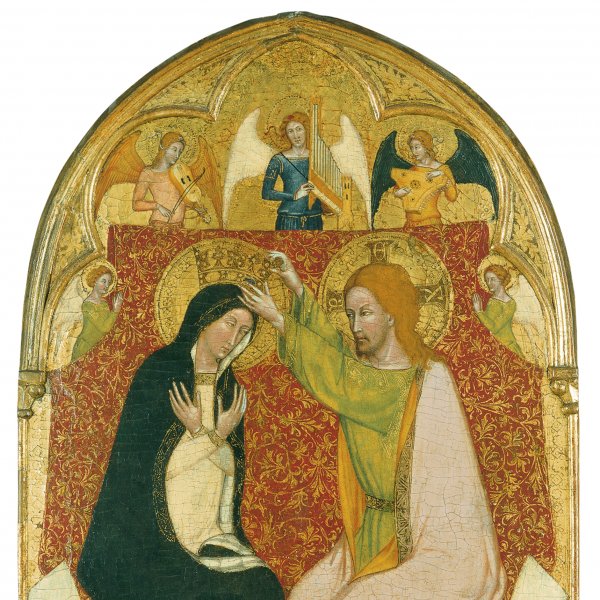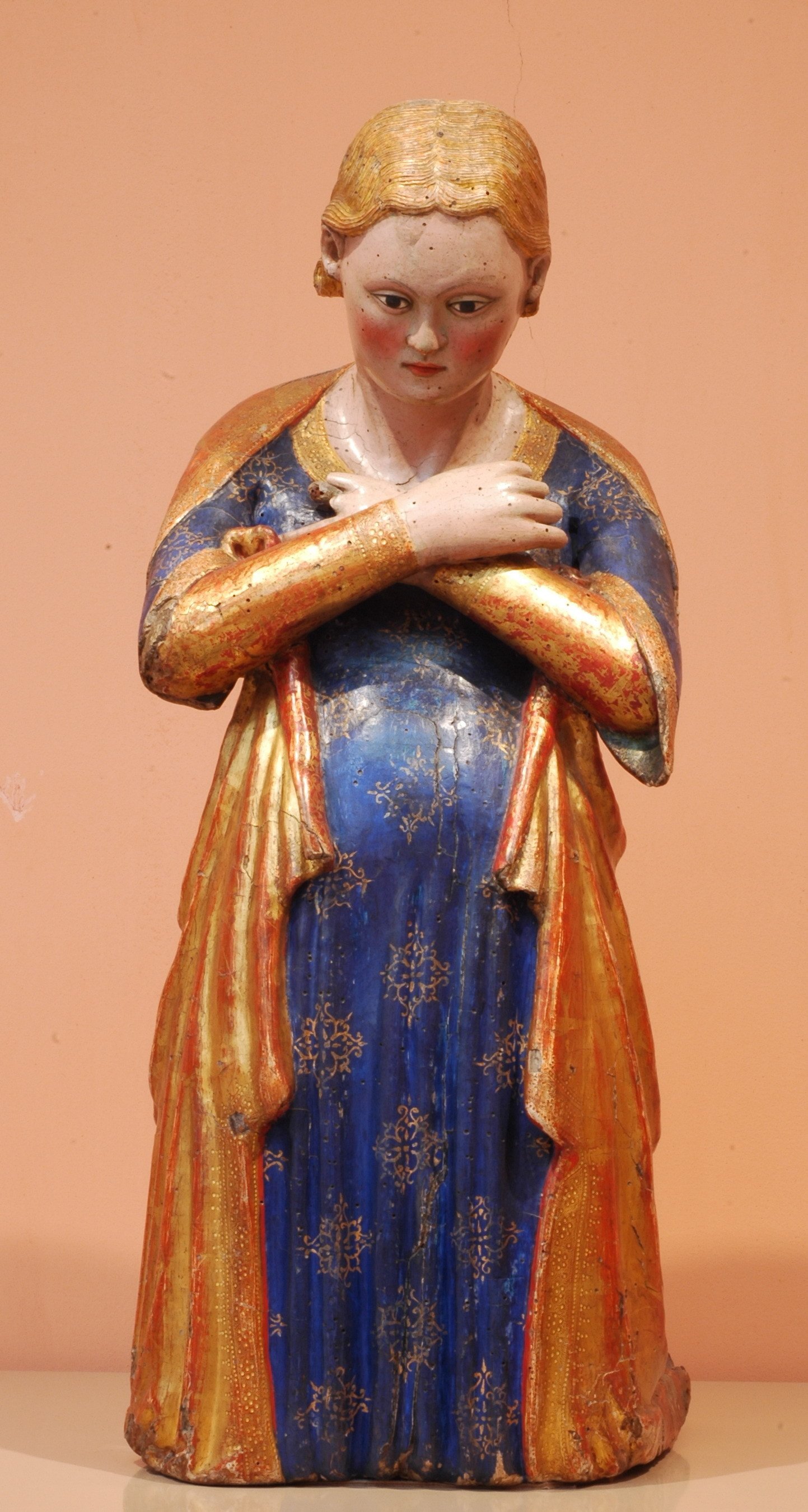The Virgin Annunciate
A close parallel for the pose of the figure, kneeling with hands crossed over the breast and downcast eyes, is to be found in the figure of the Virgin in a mid-15th century polychromed wood group of the Annunciation now in the Galleria Nazionale dell'Umbria at Perugia. While Annunciation groups in which the Virgin kneels are rare in Italian sculpture, it is clear by this analogy that the present statuette represents the Vergine Annunciata and originally formed part of such an Annunciation group in which both figures knelt. In the group at Perugia the Virgin kneels at a small lectern to which her eyes are directed downwards, and it is possible that the present figure originally did the same.
While the group at Perugia provides a close parallel for the pose of the Thyssen-Bornemisza statuette, it offers no analogies in style or facture. Unpublished before It was catalogued for the von Hirsch Sale in 1978, the statuette was then classified as Sienese and dated c. 1450 with the observation that "The same short centrally parted hair, the strong black eyes, small mouth and elegant elongated lower body is found in the Sienese standing Virgin from an annunciation group in the Bardini Museum, Florence." This is a statue in polychromed terracotta, not wood, which must date, at the latest, from the early 15th century. Its hairstyle, combed severely back and knotted into a bun, in no way resembles that of the present figure, its physiognomy is quite different, and it seems in general to offer no useful analogies in this instance. The entry was supported by an unspecific reference to Enzo Carli's La scuItura lignea senese (Milan, 1951), but Carli neither reproduces nor mentions in that work any sculpture which corresponds in a meaningful way with the present figure.
Sculpturally unambitious, the figure resists classification in terms of Italian polychromed wood sculpture of the 14th and 15th centuries. A striking correspondence can be found, however, in Sienese goldsmiths' work of the second half of the 14th century, with the reliquary bust of St. Giuliana now in the Cloisters Collection of the Metropolitan Museum of Art, New York. In this the face, with its smooth, rounded surfaces, its strongly-defined eyes under arched eyebrows and its small mouth, is treated in a closely analogous way. The short hairstyle swept back behind the ears and curled up at the bottom is also remarkably similar. There also appears to be a technical correspondence in that, as Hoving has demonstrated, the face of the bust Is modelled-up in thick gesso on a rudimentary base of repoussé copper, and it would seem that the face of the statuette was handled in the same way, being worked in exceptionally thick gesso, probably on a base which was quite summarily carved. In both pieces the finish on the face has the effect of enamelling. In both pieces the hair is gilt, and, while this is normal in a reliquary bust, it is unusual in Italian polychromed wood sculpture, in which the hair is generally painted in naturalistic colours.
The reliquary bust, according to the inscription on the gilt copper tabernacle which originally housed it (now in the Galleria Nazionale dell' Umbria at Perugia), was made to contain a relic of the cranium of St. Giuliana, presented to the convent of St. Giuliana at Perugia in 1376. It probably itself dates from 1376 or shortly afterwards. Hoving attempted to prove that the maker of the bust re-used an earlier reliquary portraying a male. He based his argument on the disparity between the features of the face in the repoussé copper shell and those modelled-up in gesso over this, and on his belief that the hairstyle (formed in the copper) was not acceptable as a female style of the 14th century, but was a male style current in the first half of that century, citing as a typical example of this the reliquary bust of St. Nicander dated 1340 in the Chiesa del Viatico at Venafro, Molise. The hairstyle of the bust of St. Nicander, which is indeed a common male style of its time, is not, however, properly analogous: it covers the ears, instead of being swept back behind them as in the bust of St. Giuliana, and hangs loosely around the head instead of clinging tightly to it. The hairstyles of the bust of St. Giuliana and of the Thyssen statuette are in fact perfectly acceptable as styles affected by young women in Siena in the middle and second half of the 14th century. Close analogies can be found for them, for instance, in the group of dancing girls in Ambrogio Lorenzetti's fresco of La Vita Cittadina neI Buon Governo of 1338-1340 in the Sala della Pace in the Palazzo Pubblico at Siena, and a precise parallel for the hairstyle of the present statuette is worn by St. Agnes in the Sienese triptych of the Resurrection with Saints formerly in the church of S. Chiara at Borgo San Sepolcro, and now in the Pinacoteca Comunale there, which must date from soon after 1360. Comparisons adduced by Hoving for the form of the repoussé shell of the reliquary with reliquary busts of the first half of the 14th century in Dalmatia are unconvincing, and it seems likely that the copper shell and the gesso face are contemporary, the former worked simply as a rough support for the latter.
According to a fragmentary inscription attached to it, the reliquary bust was made in Rome.
Hoving compared it with the great reliquary bust of St. Agatha in the CathedraI of Catania, of silver-gilt with the face and hands painted naturalistically in opaque enamels. The bust of St. Agatha bears an inscription to the effect that it was completed by the Sienese goldsmith Giovanni di Bartolo in 1376. It is thus closely contemporary with the bust of St. Giuliana. Giovanni di Bartolo Guidi is documented in papal service in Avignon and Rome between 1364 and 1385, apparently following Popes Urban V and Gregory XI in their movements between these two cities. He also worked intermittently in his native Siena and is last documented there in 1404. From 1369 to 1372 he worked in Rome, where he made for Urban V a great reliquary with the twin busts of S.S. Peter and Paul in silver-gilt, with the faces, as in the bust of St. Agatha, painted naturalistically in opaque enamels (destroyed in 1799). In 1373 at the papal court at Avignon he accepted from the Bishop of Catania the commission for the bust of St. Agatha. After its completion in 1376, he is documented in October of that year in Siena, and he probably followed Gregory XI back to Rome when the Pope returned there in January 1377. He is not recorded back at Avignon until 1380, after the death of Gregory.
Concurring with Hoving's analogy to the bust of St. Agatha, Palm has more recently linked the bust of St. Giuliana to the Roman workshop of Giovanni di Bartolo. This connection appears to be valid. Wherever the Thyssen-Bornemisza statuette was made (possibly either in Siena or Rome), its closest affinities seem to lie with Sienese metalwork. It is perhaps worth noting in this connection that Giovanni di Bartolo is generally credited with the introduction into Sienese goldsmithery of plastic, as opposed to architectonic forms. A gilt and polychromed wooden reliquary bust of St. Fina in the Museo Civico, San Gimignano presents also analogies to the present figure corroborative of a Sienese origin. The bust is plausibly ascribed by Alessandro Bagnoli to the Sienese goldsmith and sculptor Mariano d'Agnolo Romanelli (certainly recorded active in Siena 1376-1391). While clearly by a different (and sculpturally more accomplished) hand from the present figure, the bust is closely analogous in the distinctive hairstyle, the use of gilding on the hair, the separate piecing of the crown of the head (in its case to act as a cover for the receptacle for the relic), the smoothly-rounded treatment of the physiognomy and the painting of the face.
The delicate repeated gilt motif on the Virgin's blue gown is remarkably close to that which appears painted in blue and gold on the cloak of the standing Angel of the Annunciation in the Victoria and Albert Museum ascribed to Nino Pisano. As noted by Pope-Hennessy, this motif is found on Lucchese silk tissues of the second half of the 14th century. While these motifs on the present statuette are applied to a modern paint surface, it seems possible that the restorer copied them from the remains of the original paint surface of the gown.
Anthony Radcliffe





